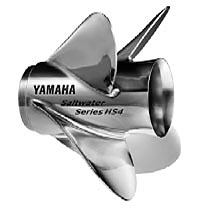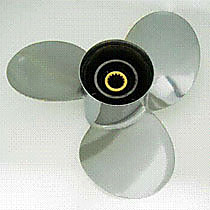Propellers are described in numbers: the first number is the diameter, and the second number is the pitch. So, a 14 x 19 propeller has a diameter of fourteen inches, and a pitch of nineteen inches. In conversation, most people would describe this propeller as a 19-inch pitch, or simply a 19.
Choosing a Propeller
What is the most important thing when choosing a propeller? Pitch. No matter what size engine or what kind of boat, if the propeller isn’t the right pitch, the boat isn’t going to live up to its potential.
Pitch is the theoretical distance, in inches, a propeller moves forward every time it turns (i.e. a 19” prop should move forward 19” with each revolution; in reality, it’s a bit less, because the propeller isn’t 100% efficient).
Here’s the skinny: You want to be able to run the engine at, or near, the manufacturer’s recommended maximum RPM at full throttle, trimmed up for speed, with a typical load in the boat – and if you can, your propeller is the right pitch.
Too much pitch (over-propped) - the engine won’t reach its max RPM, is sluggish getting on plane, and has poor throttle response. Not enough pitch (under-propped) - the boat pops on plane and accelerates with confidence, easily exceeding the recommended full throttle RPM. Neither condition is good for engine longevity or fuel economy.
The cure? Since every inch of pitch is worth about 150-200 RPM, decreasing pitch should provide a proportionate increase in RPM – drop pitch an inch, gain a couple of hundred RPM. Conversely, increasing pitch usually results in a RPM decrease – go up an inch, lose a couple of hundred RPM.
After you have the pitch part of the equation figured out, then the propeller selection process can continue.
How Do I know What Pitch is Right for Me?
Consult the engine owner’s manual to find the recommended wide-open-throttle (WOT) range for your engine. If the current propeller is at WOT RPM within the specified RPM range, select a replacement or upgrade propeller with the same pitch as the current propeller.
If the current propeller isn’t at WOT RPM within the recommended RPM range, select a replacement or upgrade propeller with a larger or smaller pitch using the following rules:
- Adding 1 inch of propeller pitch will reduce WOT RPM by 150 to 200.
- Subtracting 1 inch of propeller pitch will increase WOT by 150 to 200.
If you’re upgrading from a three blade to a four blade propeller, remember that a four blade propeller generally turns 50 to 100 RPM less than a three blade prop with the same pitch.
Pitch Points
- Generically, every inch of pitch is worth about 150-200 RPM.
- Increase pitch an inch and the full throttle RPM should drop around 150-200 RPM.
- Decrease the pitch an inch and the RPM ought to go up roughly 150-200 RPM at full throttle.
- Too few RPM at full throttle? You might need a prop with less pitch.
- Too many RPM at full throttle? A propeller with more pitch could help.
Stainless Steel vs Aluminum
It’s a question of strength and performance. Aluminum propellers usually cost quite a bit less, however, stainless steel is over five times more durable than aluminum. If you’re looking for quicker acceleration, superior top speed, or better overall performance, you should consider a stainless steel propeller.
Aluminum propellers aren’t expensive, they work well, and are relatively easy to repair, but aluminum isn’t particularly durable, making aluminum props susceptible to wear and damage.
Stainless steel propellers cost more up front; however, because stainless steel is stronger than aluminum, a stainless propeller’s blades are usually thinner and can be made in a wider variety of styles and shapes than an aluminum prop, thus the potential for better performance and increased service life.
Remember, it is stain-less steel, not stain-proof - a stainless propeller can still rust, so you need to keep it clean, just like the rest of your boat.

 Three Blades vs Four Blades
Three Blades vs Four Blades
Four blade propellers usually:
- Plane the boat faster than 3-blade propellers.
- Keep the boat on plane at a lower speed.
- Give improved mid-range speed at the same RPM as a 3-blade propeller.
- Provide quicker acceleration than most 3-blade propellers.
- Run smoother than 3-blade propellers.
- Have better holding power in rough conditions.
- Are less likely to ventilate in sharp turns.
- Provide better low speed handling.
- Are not quite as fast on the top end as a comparable 3-blade propeller.
In broad terms, three blade propellers offer good overall performance; however a three blade prop may lose its grip in turns and may not be the best handling propeller on high-horsepower rigs.
Four blade propellers can get a boat on plane faster, they’re less likely to lose traction in turns, and help many boats handle better, although a four blade propeller is often a bit slower (1-2 MPH) at top speed than a three blade propeller.
What are Some Common Signs it is Time for a New Propeller?
Your boat takes longer to get on plane than it used to. It uses more fuel. It doesn’t seem to run as fast as it did when it was new. If your boat feels sluggish, one of the first things you should check is your propeller. Is it showing signs of wear and tear ? Does it have more than its share of nicks, dings and missing paint ?
These symptoms can accumulate and significantly impair the performance of a perfectly good engine.
How Should I Maintain and Service My Propeller?
 Essential to good propeller maintenance is periodic inspection to detect even small dings, which can lead to blade failure if not dressed or repaired.
Essential to good propeller maintenance is periodic inspection to detect even small dings, which can lead to blade failure if not dressed or repaired.
A damaged propeller, even one that only appears slightly damaged by running through silt and sand, can significantly reduce performance efficiency and fuel economy, and can more severely damage itself through cavitation erosion emanating from the blades' irregular leading edges (Figure 8-42).
In one test with a damaged propeller, top speed fell more than 13%. Acceleration was off over 37%. Optimum cruise miles slowed 21 %. Worse yet, damage usually is not done to each blade uniformly and, therefore, the damage can set up imbalance vibrations that can cause fatigue damage to other parts of the engine or drive. If you use your boat in shallow or rocky waters, you will want to check your propeller more frequently for possible damage.
Up to a point, dealers can have a propeller restored to like-new condition; however, extreme damage can be more expensive to repair than the cost of a replacement. Minor damage corrected early on can prevent much more serious and costly repair later on to both the propeller and other parts of the engine.
Propeller repair, as well as customizing, can include adjustments to pitch, rake, cup, and blade thickness.
To aid in the future removal of the propeller, liberally coat the propeller shaft spline with Anti-Corrosion Grease. To assure that the propeller remains secure on the shaft during the season, periodically check the self-locking prop nut for tightness.
